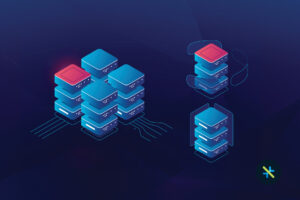The future of banking is “digital”, and digital means data. The COVID-19 pandemic put digitalization in high gears for the banks and financial services (BFS) institutions and the role of data as a strategic decision-making tool is proving to be monumental. The focus is on being more customer-centric and not account-centric in the data approach and that is what leads to business growth and long-term success. The winning enterprise data strategy is defined by how smartly the data is used to serve the customers better. And the first step in this data game is to embrace data modernization – breaking out of legacy systems and deciding to embrace a modern data architecture
Before we dive deeper into understanding data modernization and the importance of having a modernized data platform in more detail, let us first take a look at some of the challenges that banks and financial services companies face today and why there is a strong need to modernize.
Challenges Faced by Banks and Financial Services Institutions
- Rapidly rising customer expectations
- Competition driven by Open Banking, FinTech and Neo Banks
- Prevalence of account-centric banking (Lack of “Single View of Customer”)
- Digital transformation processes by today’s banks do not take into account the need for a robust data platform
- A plethora of customer data waiting to be leveraged (Volume, Velocity, Variety, Veracity, and all in all the Value of data)
- The need to ensure Correctness, Completeness, and Consistency of data
Breaking Out of Legacy Data Systems
Banks & Financial Services companies that are still continuing with legacy data systems or file-based systems may encounter a host of challenges and limitations due to the decentralized data approach. Some of these challenges of legacy data systems include:
- Separated, isolated, and siloed data
- Limited data accessibility
- Data duplication
- Data inconsistency
- Data security
- Incompatible file formats and varied extensions
- Size limitations
Hence, BFS organizations must pursue data modernization to realize the full potential of data in terms of getting faster access to the right data, real-time data analysis, scalability, and seamless integration across the organization in their endeavor to meet rising customer expectations.
Data Modernization – The Need of the Hour
Data modernization is about creating a seamless extension of legacy data assets, repurposing historical data, transforming to modern data architectures, and ensuring the modern data assets are aligned with legacy data assets using the latest technologies such as AI and ML. Data modernization is at the grassroots of a digital business, which is what the banking and financial services industry has evolved into today.
Digital transformation has become more mainstream in current times – the post-covid era – and digitalization always results in phenomenal volumes of data generation. To give you an idea of the mind-boggling numbers – according to a report by Raconteur, 463 exabytes of data will be generated each day by people as of 2025! Therefore, the need of the hour is addressing the challenge of storing such large volumes of data and processing this data efficiently to draw actionable and monetizable insights. How do enterprises accomplish that goal? Data modernization is the key!
Without the right data modernization strategy, not only handling big data is a challenge, but also managing the high “velocity, variety, value, and veracity” of data is a big concern. The end objective is more efficient and accurate data analysis to draw meaningful insights; all of this while ensuring business continuity.
First Step to Data Modernization
Once a decision has been taken to embark on the modernization route by bringing in a modernized data platform, the next call is whether to build this platform on cloud or on-premise by evaluating the pros and cons of both options.
Why Cloud?
Traditional Data Platform Vs. Cloud Data Platform
Traditional Data Platform
Cloud Data Platform
Obsolete with limitations
Fast, modern, and technology-driven/ technology-compatible
Overhead costs of additional installations
Cost-saving – easy to manage and run
Slow, cumbersome, and less productive
Efficient and productive
Constrained and limited
Scalable and flexible – open and adaptable
Scattered data leading to data loss
Single, centralized data access – No lost data
Siloed data – restricted internal sharing
Easy internal sharing of data
Restricted access to data
Simultaneous, multiple access to data
Limits product/ service innovation
Supports product/ service innovation
Confines customer experience
Enables enhanced customer experience
The Journey of Data Modernization Begins Here…
The data modernization process revolves around building a modern data framework that comprises a series of steps and processes, with modern technologies at the core of each of these. A robust Data modernization strategy includes 8 essential elements that enable financial enterprises to experience a higher ROI by building an accessible, scalable, and compliant data ecosystem:
- Data Migration
- Integration & Ingestion
- Data Cleansing & Transformation
- Data Rules & Polymorphic Data Stores
- Data Modeling/Storage
- Data Quality Management
- Data Warehousing/ Big Data
- Data Visualization, Analytics & Democratization
We will deep dive into each of these eight elements of building a robust data modernization process in our next blog post.
The End Objectives of Data Modernization
Any enterprise (Banks & Financial Services companies in this case) should be able to achieve the following 3 key objectives through their Data Modernization effort:
- Build a modern data platform that addresses “Correctness, Completeness, and Consistency of data” through “Eyes on Glass” monitoring of data quality.
- Devise a “Scalable, Reliable, Maintainable” enterprises, data modernization strategy.
- Focus on the “Democratization” of data and the “Commercialization or Monetization” of data
Data Modernization –> Data Democratization –> Data Commercialization or Data Monetization
Concluding Thoughts
BFS organizations that are yet to acknowledge the worth of data and the potential of data modernization, may have to be prepared to be outsmarted by the new entrants implementing smart data-driven strategies in the financial services market. A successful data modernization strategy is the real gamechanger and the key to long-term success.
If you are ready to begin this journey of data modernization, look no further. Get guidance from our next post in this series that covers the entire 8 essential elements of a successful data modernization strategy. We at KANINI can help you in your digital transformation with a winning data modernization strategy. Contact us to know more about how we help enterprises with end-to-end data services.
Author

Anand Subramaniam
Anand Subramaniam is the Chief Solutions Officer, leading Data Analytics & AI service line at KANINI. He is passionate about data science and has championed data analytics practice across start-ups to enterprises in various verticals. As a thought leader, start-up mentor, and data architect, Anand brings over two decades of techno-functional leadership in envisaging, planning, and building high-performance, state-of-the-art technology teams.








